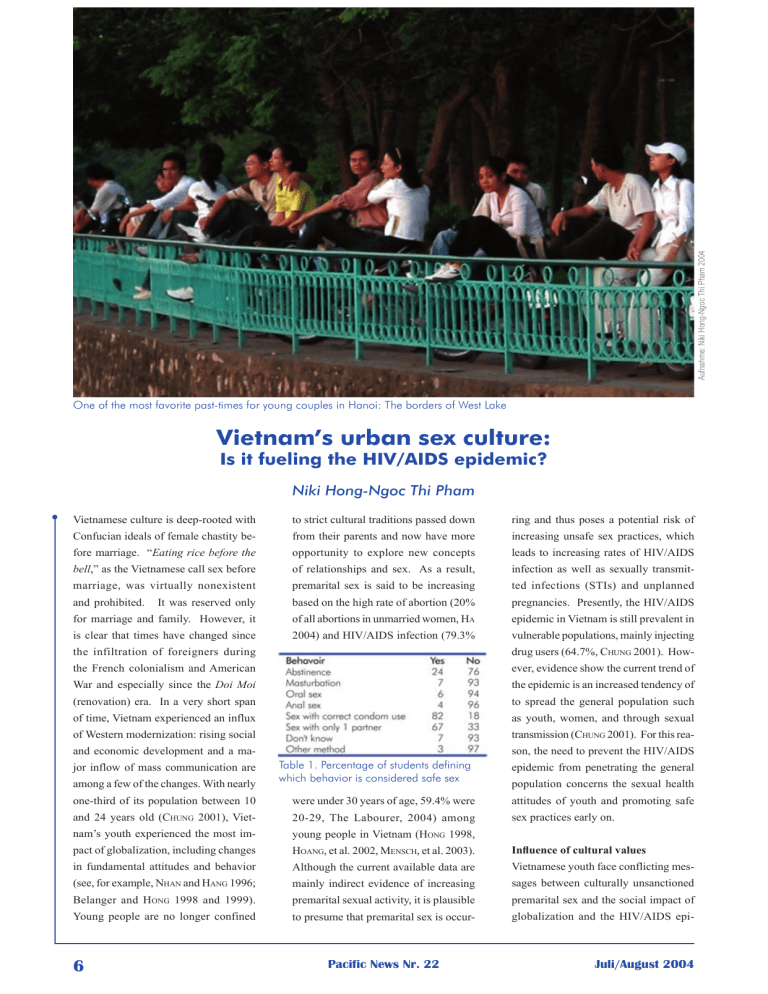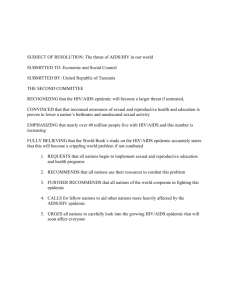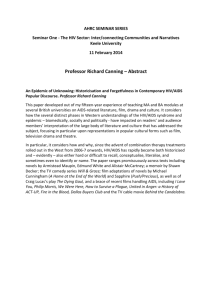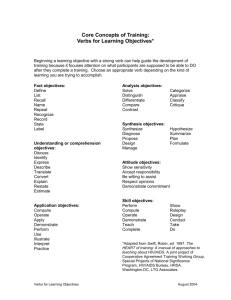
Aufnahme: Niki Hong-Ngoc Thi Pham 2004
One of the most favorite past-times for young couples in Hanoi: The borders of West Lake
Vietnam’s urban sex culture:
Is it fueling the HIV/AIDS epidemic?
Niki Hong-Ngoc Thi Pham
Vietnamese culture is deep-rooted with
to strict cultural traditions passed down
ring and thus poses a potential risk of
Confucian ideals of female chastity be-
from their parents and now have more
increasing unsafe sex practices, which
fore marriage. “Eating rice before the
opportunity to explore new concepts
leads to increasing rates of HIV/AIDS
bell,” as the Vietnamese call sex before
of relationships and sex. As a result,
infection as well as sexually transmit-
marriage, was virtually nonexistent
premarital sex is said to be increasing
ted infections (STIs) and unplanned
and prohibited.
It was reserved only
based on the high rate of abortion (20%
pregnancies. Presently, the HIV/AIDS
for marriage and family. However, it
of all abortions in unmarried women, HA
epidemic in Vietnam is still prevalent in
is clear that times have changed since
2004) and HIV/AIDS infection (79.3%
vulnerable populations, mainly injecting
the infiltration of foreigners during
drug users (64.7%, CHUNG 2001). How-
the French colonialism and American
ever, evidence show the current trend of
War and especially since the Doi Moi
the epidemic is an increased tendency of
(renovation) era. In a very short span
to spread the general population such
of time, Vietnam experienced an influx
as youth, women, and through sexual
of Western modernization: rising social
transmission (CHUNG 2001). For this rea-
and economic development and a major inflow of mass communication are
among a few of the changes. With nearly
son, the need to prevent the HIV/AIDS
Table 1. Percentage of students defining
which behavior is considered safe sex
epidemic from penetrating the general
population concerns the sexual health
one-third of its population between 10
were under 30 years of age, 59.4% were
attitudes of youth and promoting safe
and 24 years old (CHUNG 2001), Viet-
20-29, The Labourer, 2004) among
sex practices early on.
nam’s youth experienced the most im-
young people in Vietnam (HONG 1998,
pact of globalization, including changes
HOANG, et al. 2002, MENSCH, et al. 2003).
Influence of cultural values
in fundamental attitudes and behavior
Although the current available data are
Vietnamese youth face conflicting mes-
(see, for example, NHAN and HANG 1996;
mainly indirect evidence of increasing
sages between culturally unsanctioned
Belanger and HONG 1998 and 1999).
premarital sexual activity, it is plausible
premarital sex and the social impact of
Young people are no longer confined
to presume that premarital sex is occur-
globalization and the HIV/AIDS epi-
6
Pacific News Nr. 22
Juli/August 2004
Table 2. Percentage of students reporting their source
of information about sex
tioned about premarital
intercourse is not acceptable before mar-
sex, relationships, family,
riage. Other behaviors including holding
safe sex and contraceptive
hands, groping, kissing, and hugging are
methods, and HIV/AIDS.
acceptable before marriage by the major-
University students in Ha-
ity of the students (77%-98%). From a
noi were selected both for
gender appropriate perspective, 38% of
their higher education level
students think it is “bad” for females to
and urban environment.
have premarital sex and 24% for males
Sensitivity and privacy is-
to have premarital sex. In addition, 72%
sues were considered in the
of students feel that Vietnamese tradi-
distribution and collection
tion and culture influence premarital
demic. This raises concern in developing
of questionnaires to collect the most
sex attitudes and practices in a “restric-
appropriately responsive adolescent re-
possible accurate data. Students were
tive” manner and 80% of students say
productive health and HIV/AIDS pre-
allowed and encouraged to answer the
their parents would strongly disapprove
vention programs. Youth today are un-
questionnaires at home or in private and
if they knew they had premarital sex.
der social pressure brought by economic
to return the questionnaires in a sealed
Based on these results, young people
changes after Doi Moi whilst still bound
envelope in an enclosed container or to
are beginning to be less judgmental and
by traditional regulations (HOANG 2002).
the teacher or researcher. Questionnaires
accepting of premarital sex, but Viet-
This gap between Vietnamese cultural
were anonymous and voluntary.
namese culture still appears to have a
values and the modern values of Doi Moi
strong influence on their attitudes about
create confusion and vulnerability in de-
premarital sex. It is still generally per-
veloping healthy attitudes and practicing
ceived that premarital sex is inappro-
safe sex in sexual relationships. The
priate and there is a double standard
question is: how strong is the influence
of traditional Vietnamese culture and
values on urban youth and how does it
Table 3. Percentage of students selfevaluating their level of knowledge about
sexual health/safe sex
for females.
Knowledge level about HIV/AIDS
affect them today living in an open and
Attitudes of urban youth
A major determinant of assessing risk of
rapidly changing economy as they make
An important indicator of changing at-
HIV infection is level of knowledge of
choices in their sexual relationships?
titudes of sexuality is the definition of
HIV transmission and prevention. When
To attempt to understand if and how
premarital sex. The Vietnamese often re-
asked how HIV is transmitted, 94% of
the Vietnamese culture influence young
fer to “having sexual relations” as “quan
students correctly answered that it is
people’s sexual lives, a research project
he tinh duc,” which can range anywhere
transmitted through blood, semen, and
sponsored by the U.S. Fulbright Scholar-
from holding hands to intercourse. The
vaginal fluids. However, only 49% of
ship Program was conducted from 2003-
Vietnamese prefer to use the respectable
students knew that HIV cannot be trans-
2004 to assess the knowledge, attitudes,
and gentler phrase, “quan he tinh duc”
mitted through saliva, urine, tears, or
and practices of urban Vietnamese youth
versus a more direct term that means in-
sweat. In terms of knowing the benefits
concerning safe sex and HIV/AIDS. The
tercourse, “giao hop” because it is still
of condom use, results showed that 78%
objective of the research is to try to iden-
taboo to talk openly about sex. To evalu-
and 70% of students know that condoms
tify cultural and social values youth have
ate how youth currently define “quan he
are used to prevent HIV/STI transmis-
today that may be fueling the HIV/AIDS
tinh duc,” students were asked, “what is
sion and unplanned pregnancies, respec-
epidemic among urban youth via unsafe
considered sex?” Between 14-22% of
tively. Table 1 shows the knowledge
sex practices.
students perceive groping, kissing, and
level concerning which behaviors they
hugging as “having sexual relations.”
perceive are safe or not. According to
Research design
Most interestingly, 18% answered that
the students surveyed, the majority of
A questionnaire was developed in col-
intercourse does not constitute “having
students know correct condom use is a
laboration with the Center for Women’s
sexual relations.” This means young
safe sex method. In summary, students
Studies at Vietnam National University,
people are beginning to be more com-
do know basic modes of HIV transmis-
Hanoi. It was distributed in September
fortable with using direct terms
2003 to 400 students at Vietnam Na-
of sexual intercourse instead of
tional University and it’s partner col-
the traditional roundabout terms
leges. Students ranged from first year to
implying sexual intercourse.
fourth year (17-26 years) in University,
When asked about acceptable be-
but over half of the students surveyed
haviors before marriage, 79% of
were 21-22 years. They were ques-
students surveyed feel that sexual
Juli/August 2004
Pacific News Nr. 22
Table 4. Percentage of students expressing their
level of concern for preventing HIV/STIs if they
would have sex
7
sion and prevention methods but it
a step away from the cultural and social
tries, Thailand’s reported condom use
is not yet comprehensive. One of the
stigma of carrying a condom.
is less than 30% and Japan’s is less than
possible reasons for this is that 89% of
60% among young people (SCHUETTLER
the students reported their source of in-
Premarital sex and safe sex
2003). It seems to be that Vietnam’s
formation about sex were from books,
It is difficult to be certain that young
youth are fairly comparable in condom
magazines, and/or newspapers (Table 2).
people are having more premarital sex,
use, if not better than some of its Asian
This shows their source of information
but this is not the underlying concern.
counterparts.
is providing basic knowledge about sex
The issue is if they are having premarital
and sexual health issues, but it may not
sex, it is critical they are practicing safe
What is fueling the
be complete or clear.
Thus, this may
sex. Students were asked about their
HIV/AIDS epidemic?
cause misunderstanding or misinforma-
current relationship status at the time of
In a country where HIV prevalence is
tion about sexual health issues, most im-
the research. Almost half (45%) of the
mainly among injecting drug users but
portantly about safe sex practices.
students responded they never had a boy-
clearly spreading through heterosexual
Students were also asked to self-evaluate
friend/girlfriend before and 20% repor-
transmission (mainly in the South) to
their level of knowledge about sexual
ted they did but not at the present time.
the younger population, the concern for
health. Most students felt they don’t
When asked if they have ever had sexual
understanding what is fueling the in-
have enough, little, or no knowledge
intercourse, only 5% reported they had
creasing infection rates is critical (CHUNG
and only 11% felt they had complete
(Table 5). The age range reported having
2001). The data presented here suggest
knowledge (Table 3).
Although the
that young people are still strongly influ-
majority of students felt they didn’t have
enced by cultural values and social stig-
enough knowledge about sexual health
ma, therefore still not commonly prac-
issues, very few of them expressed they
were concerned about the issue. Table
4 shows only 35% of students were con-
Table 5. Percentage of students report having
had premarital sexual intercourse
ticing premarital sex. Although the data
is not fully representative of all youth in
Vietnam, it is important to note that 82%
premarital sex for the first time was 14 -
of the students came from the rural areas
they were to have sex. In addition, only
25 years, but the majority were between
and moved to the city to study (which is
52% of the students feel that condoms
19-22 years. Of those reported having
similar to the distribution of the popu-
should be carried when intending to
had sexual intercourse, 62% reported
lation). This may explain the bias for
have sexual intercourse. This indicates
condom use. Table 6 shows the distri-
the study sample to still possess strong
that knowledge of condom use does not
bution of contraceptive methods used by
cultural values. However, a strong ru-
guarantee actual condom use. However,
students who reported having had pre-
ral background balanced with a taste of
15% responded that males (9% for fe-
marital sexual intercourse. Among the
urban culture and higher education may
males) should carry condoms with them
younger population, it is common to use
possibly better represent a mixture of
at all times. This can be interpreted as
natural methods of contraception, such
extreme rural versus urban youth as well
an influence of Western education about
as withdrawal, rhythm, or no method
as more representative of the migration
always carrying a condom to be safe and
at all. In comparison to other coun-
trend of Vietnamese youth. In addition,
Aufnahme: Michael Waibel 2004.
cerned about preventing HIV/STIs if
Romantic Times for Young Vietnamese, Quay at Saigon River, Ho Chi Minh City
8
Pacific News Nr. 22
Juli/August 2004
low compare to Thailand, Myanmar, and
Cambodia (CHUNG 2001), it is apparent
that more comprehensive education and
a general social acceptance about premarital sex is needed for youth. This
Aufnahme: Niki Hong-Ngoc Thi Pham 2004
would allow for Vietnam’s sex culture
A change from the motorbikes to the swanboats on West Lake, Hanoi
one can speculate that rural youth may be
young people? One of the possible ex-
more culturally influenced and less edu-
planations may be the uncontrollable
cated, thus less inclined to practice safe
flood of mass media communication in
sex if they have premarital sex. Other
Vietnam around HIV/AIDS issues and
research report that Vietnam’s youth are
“social evils.” Too much information
not engaging in premarital sex earlier or
or inaccurate information may be over-
significantly more than other Southeast
whelming and leading to increasing
Asian countries (MENSCH, et al 2003).
misinformation, confusion, and stigma-
Parents still disapprove of premarital sex
tism. Young people may feel invincible
and the double standard still exists. At
against the epidemic and think it only
the same time, more and more younger
happens to those who inject drugs or buy
people are starting to feel that having
or sell sex. Young people feel condoms
show a lack of trust and girls need
to give “everything” to prove their
love (EFROYMSON, et al.). Condom
social marketing may also be failing in its effectiveness and message. Recently, Vietnam banned
Table 6. Percentage of students using contraceptive methods who report having had premarital sexual intercourse
television and radio from airing
advertisements for condoms and
other products at dinner-time, say-
sex before marriage is normal (see also
ing they were unsuitable to “Vietnamese
HOANG, et al 2002, HONG and NGA 1997,
psychology and traditional customs”
BELANGER and HONG 1996). The results
(SCHUETTLER 2003). What appears to be
also suggest younger people have a ba-
fueling the epidemic is a combination of
sic level of knowledge about HIV/AIDS
existing cultural and gender influences,
transmission risk and safe sex methods.
modern social pressure around sexuality,
Practice of condom use is higher than
increasing mass media communication,
natural methods and condom social ac-
stigmatisation of the HIV/AIDS epi-
ceptance appears higher. If attitude is
demic, and a rapidly changing society.
still strongly traditional and integrated
Consequently, all these factors together
with a relatively high level of knowledge
weave a complex barrier for youth to
and practice of safe sex, then what are
have strong healthy sexual attitudes and
other factors or barriers that are still
practices.
causing rising HIV infections among
among youth in Vietnam is still relatively
Although HIV prevalence
to be more open to understand all the
various cultural, social, and economic
issues that are necessary in promoting
healthy sexual attitudes and safe sexual
practices.
References
BELANGER, DANIELE and KHUAT THU HONG
1998. “Young single women using abortion in Hanoi, Vietnam.” Asia-Pacific Population Journal 13(2): 3-26.
_______. 1999. “Single women’s experiences of sexual relationships and abortion in Hanoi, Vietnam.” Reproductive
Health Matters 7(14): 71-82.
CHUNG, A. 2001. “Vietnam’s National HIV/
AIDS Programme: HIV/AIDS Country
Profiles.” Hanoi: National AIDS Standing
Bureau of Vietnam.
EFROYMSON, DEBRA, VU PHAM NGUYEN THANH,
NGUYEN QUYNH TRANG, and SIAN FITZGERALD.
(published date unknown). “Barriers to
safer sex among Vietnamese youth.” PATH
Canada.
HOANG, TU ANH, DINH THU PHUONG, NGUYEN
THU HUONG, and BUI THANH TU. 2002. “Assessing the Vietnam situation: HIV/AIDS
communication in context.” Consultation of
Investment in Health Promotion.
HONG, KHUAT THU. 1998. “Study on Sexuality in Vietnam: The Known and Unknown
Issues.” Regional Working Papers. Hanoi:
Population Council.
HA, LE. 2004. “Vietnam has highest abortion rate in the world.” VietnamNet Bridge:
April 26, 2004
Labourer, The. 2004. “HIV cases higher
among under-30s in VN.” Vietnam News:
January 3, 2004
MENSCH, BARBARA S., WESLEY H. CLARK, and
DANG NGUYEN ANH. 2003. “Adolescents in
Vietnam: Looking Beyond Reproductive
Health.” Studies in Family Planning 34(4):
249-262.
NHAN, VU QUY and NGO DANG MINH HANG.
1996. “Reproductive Behavior of Unmarried Urban Students of Age 17-24 in
Vietnam.” Research Report Series. Hanoi:
National Committee for Population and
Family Planning and Centre for Population
Studies and Information.
SCHUETTLER, DARREN. 2003. “Asian governments urged to promote condoms in AIDS
fight.” Reuters NewMedia: August 18,
2003.
Niki Hong-Ngoc Thi Pham [nikitpham@yahoo.com] received her BS in Biology and Women’s Studies at the University of
Michigan, Ann Arbor in 2000 and was a U.S. Fulbright Student at the time of research. She is now a consultant for the
U.S. Centers for Disease Control and Prevention in Vietnam and is thrilled to be attending the London School of Hygiene
and Tropical Medicine for a MSc in Reproductive and Sexual Health Research in September 2004.
Juli/August 2004
Pacific News Nr. 22
9



![vietnam[1].](http://s2.studylib.net/store/data/005329784_1-42b2e9fc4f7c73463c31fd4de82c4fa3-300x300.png)
